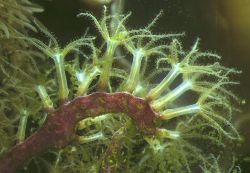 FAMILY: CLAVULARIIDAE
FAMILY: CLAVULARIIDAE
The terms, Star Polyps and Clavularia may be rather unfamiliar to many marine aquarists but all marinists interested in invertebrates will have come across the many species of the these delightful colonies, if they do not already own one or two. Unfortunately, the family Clavulariidae, commonly known as Star Polyps, has long been confused with Xenia to which it superficially resembles; so much so, that it has, quite wrongly, been labelled Xenia with gay abandon and little regard for correct scientific terminology. To put the record straight, Xenia are Pulse Corals with polyps held on elongated stems, unable to withdraw into a basal mass. On the whole, they are far more sensitive than the clavularids and usually require optimum water and lighting conditions. Star Polyps, on the other hand, are not a difficult coral to keep and often make an ideal choice for the newcomer to invertebrates.
A Large Variety Of Species
Clavularia species (or Star Polyps, as they hopefully will be more correctly known in future) are many and varied in colour, but they do have certain qualities that make them easy to identify.
Firstly, whilst retaining an eight-point and star-like symmetry to their tentacles, the stem is usually quite short (hardly ever more than 12mm in length) and the polyps are held close to its base. The base is a fused, encrusting mass which is rather rubber-like in quality; it is usually purple in coloration but can be shades of brown in some species. The polyps can quickly withdraw totally into their base leaving little for predators to browse upon and giving full protection from all but the most determined of attackers. When the polyps do emerge, the density of polyps is such that the base is entirely hidden.
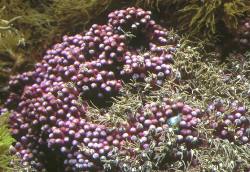 Polyp coloration varies from species to species, but includes varying degrees of green, brown and silvery-grey. The 'eye' of the polyp is often white, giving rise to the common name Star Polyp.
Polyp coloration varies from species to species, but includes varying degrees of green, brown and silvery-grey. The 'eye' of the polyp is often white, giving rise to the common name Star Polyp.
Reproduction
The most common method of reproduction in the marine aquarium is by division. This occurs as the basal mass increases in size and develops new polyps. Most hobbyists keeping Clavularia under reasonable conditions have found that it spreads rapidly; as much as one centimetre every month, according to the species. This rapid rate of growth quickly gives the new aquarium an established appearance as the polyps quickly cover previously bare rockwork or glass. So rapid is its spread in the wild that gorgonians and sea whips positioned close to a colony will often find the polyps spreading briskly up their branches, gradually killing the 'host' as it does so! Star Polyp 'trees' are the result and are readily available in the aquarium trade (although they are still quite wrongly called 'Xenia Trees').
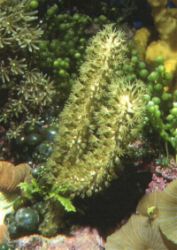 Star Polyps will also carry over this unwelcome habit into the marine aquarium, and it would therefore be wise to keep gorgonians and sea whips at a comfortable distance if they are to be preserved in their original state!
Star Polyps will also carry over this unwelcome habit into the marine aquarium, and it would therefore be wise to keep gorgonians and sea whips at a comfortable distance if they are to be preserved in their original state!
Clavularia also reproduces sexually with eggs and sperm being shed into the open ocean to found colonies in far away locations but this does appear to be a rare occurrence within the aquarium and cannot be relied upon as a means to spread a favoured species to the other end of a large aquarium.
If the hobbyist wishes to achieve rapid colonisation in other parts of a display then portions of a well-established colony can be carefully eased off of a rock and placed elsewhere. Those species which form more of a mound-like structure can be cut with a very sharp scalpel and the pieces distributed accordingly. This may appear to be brutal treatment but in reality the colonies recovers very quickly and are soon ready to start spreading once more. Another less reliable method of propagation requires that the mother colony is left in a particular location for several months whereafter it is moved to a new location. In that period several polyps will have spread onto the surrounding rocks and be left behind as the main colony is removed. These individuals will then be free to form a colony of their own.
Feeding 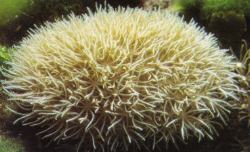
It has been suggested that species within the family Clavulariidae do not feed on microscopic plankton but gain all their nutrition from the symbiotic algae within the polyp tissues, and this would appear to make a great deal of sense. The polyps are constantly on show and have been observed to make no attempt to collect or capture live foods even if they are offered. Indeed, they tend to withdraw until the water is clear once again! Such feeding behaviour is to be welcomed as unnecessary pollution from food additives is avoided altogether.
Threats To Health
Clavularid colonies are highly resistant to disease but they do suffer occasional predation from certain snails and nudibranchs such as Pleuroleura striata. If the colonies are observed during the hours of darkness, any predatory nudibranchs can be identified and removed.
Sometimes a colony of Clavularia refuses to extend its polyps for some weeks, and although reasonably resilient, Clavularia will not tolerate deteriorating water conditions brought about by lack of water changes, overfeeding or overstocking with fish. If the latter are attended to, several large water changes will often help the star polyps into recovery.
Good water circulation is essential, as sluggish, stale water gathering around the polyps will encourage a very poor showing, whereas heavy turbulence promotes good aeration and an increase in polyp vitality.
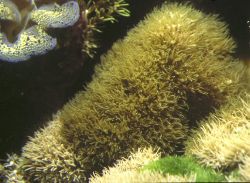 It is essential that they do not become smothered by nuisance algae or overgrown by decorative algae. Once established in a colony, it is almost impossible to fully eradicate the deeply rooted holdfasts of algal species such as Caulerpa.
It is essential that they do not become smothered by nuisance algae or overgrown by decorative algae. Once established in a colony, it is almost impossible to fully eradicate the deeply rooted holdfasts of algal species such as Caulerpa.
Clavularia colonies can be positioned close to each other but it is likely that the most vigorous species will overtake the slower growing of the two; eventually, the latter will be lost.
Occasionally, polyps refuse to appear from a basal structure that has been 'dormant' for some months but there is hope. In many cases, where environmental conditions are improved drastically, colonies will often slowly recover to full health, even though it might originally appeared to have been dead!
Useful Clavularia
Clavularia can also perform a useful, practical function in the aquarium. Where an invertebrate aquarium is without a substrate, Clavularia can be encouraged to form a living mat of polyps over the base, thereby disguising the bare glass.
Tank and Water Conditions
An aquarium of 25 gallons nett, or above. Ammonia & nitrite: zero at all times Nitrate: 15ppm total N0 or preferably much less. Specific Gravity: 1.021-1.024 Temperature: 25-26°C (77-79°F) pH: 8.1-8.3 Water Changes: 15-20% every two weeks with good quality filtered water. Efficient protein skimming and activated carbon filtration must be seen as standard.
© Nick Dakin. May not be reproduced in part, or whole, without permission.

